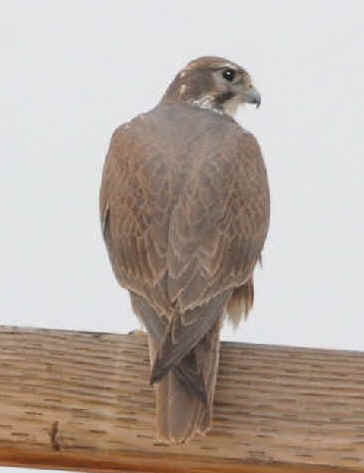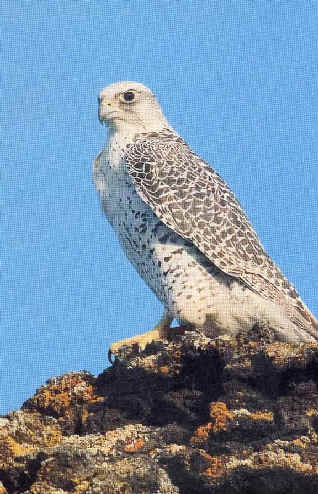 |
PO Box
9021, Wilmington, DE 19809, USA E-mail: font@focusonnature.com Phone: Toll-free in USA 1-800-721-9986 or 302/529-1876 |
 |
PO Box
9021, Wilmington, DE 19809, USA E-mail: font@focusonnature.com Phone: Toll-free in USA 1-800-721-9986 or 302/529-1876 |
With
Falcons, now and then, and a Green Sea Turtle
Armas Hill has presented the "Birdline", originally from
Philadelphia, on the phone and internet for over 3 decades, and on the radio
in Delaware for about 10 years.
Links:
A
List & Photo Gallery of North American Birds, in 6 Parts
A List & Photo Gallery of North American Mammals

Prairie Falcon
(photo by Howard Eskin)
The Birdline & Natureline for December 15, 2011:

A white
Gyrfalcon
From the January 4, 1982 Birdline:
It is a new year, and this is the first edition of the
Birdline for 1982. Highlights include these birds, in
Pennsylvania: the previously-reported WHITE GYRFALCON, a
newly discovered DARK GYRFALCON, a BLACK-LEGGED KITTIWAKE on a
lake upstate, a BLACK-BACKED 3-TOED WOODPECKER, some BOREAL
CHICKADEES, lots of PINE GROSBEAKS, and some GOLDEN EAGLES.
A review of area Christmas Counts will be given later, but, now,
let's begin this tape with a bird that has spent the last 5
weeks or so in an area that is not included in any
Christmas Count Circle. And that bird happens to be not only the
most outstanding bird that's been in our region, but also
anywhere in the Northeast US so far this Winter - the
WHITE-PHASED GYRFALCON in the Amish Farm Country of
Lancaster County, Pennsylvania. It continues to be seen in
that same area of the county, west of New Holland.
It was first discovered there, you may remember, back on
November 27 (1981), but now more and more people having been
seeing the WHITE-PHASED GYR.
Certainly responsible for this has been the discovery of a
tree where the GYRFALCON often spends the night. The
bird has been seen either leaving that tree early in the
morning, often by 7am, or returning to it around 4 o'clock in
the afternoon. The latter time has often provided more
rewarding sightings, as the bird stays and the light is better.
In recent days, the GYRFALCON has returned to the tree at about
4pm on December 29, 30, 31 and January 2 and 3. It did not
appear there, however, in the late afternoon on January 1,
although it was seen in flight in the area, earlier that day.
An area where the bird has been seen, with some regularity,
during the day has been a few miles west of the tree. On
December 30, for example, it was seen eating a PIGEON and then
preening, along Brethren Church Road.
Another bird, described well as a DARK-MORPH GRAY GYRFALCON was
seen, around 3pm on January 1, also in Lancaster County, along
Doe Run Road, behind the Manheim Shopping Center, east of
Manheim, and north of Lancaster. The bird was seen flying and
diving, and it was photographed.
Returning to the WHITE-PHASED GYR for a moment, please do not
leave the road to get closer to the bird when it is in the roost
tree. A few people went onto the field, yesterday afternoon,
January 3, and the bird left.
Also in that area of Lancaster County, west of New Holland,
numbers of ROUGH-LEGGED HAWKS continue to be seen, both
DARK and LIGHT-MORPH BIRDS.
Estimates of those numbers, in that area, range from 50 to 75
ROUGH-LEGGED HAWKS.
Yet another bird from the North was present, in that Amish
Farm Country, west of New Holland: a SNOWY OWL. But the bird was
not reported again after December 23 (1981).
From the January 9, 1982 Birdline:
Actually, at least 4 GYRFALCONS have been seen in
eastern Pennsylvania in the last two months.
Back on November 14, 1981, two hawk-watchers, Ken Kranick and
Dave Simpson, were on the Kittatinny Ridge, at a place called
Baer Rocks.
Both of these men have had considerable hawk-watching
experience, and both of them enjoy spending their time in that
pursuit.
Ken, for example, during the 1981 Fall Season, spent 65 days on
the ridge watching hawks. He has done much the same for the last
14 years.
The late Maurice Broun - who, as many of you know, was the first
curator at Hawk Mountain Sanctuary for many years - spent a
number of his later years observing autumn hawk flights, with
Ken, at Baer Rocks, located just a few miles south of Bake oven
Knob.
It was from Baer Rocks, back on November 14, that Ken and Dave
saw a BROWNISH GYRFALCON. The bird flew below them, circled
a couple times, and then went on. At one point, it passed within
200 feet of them.
Exactly, one week later, on November 21, Ken and Dave saw
another GYRFALCON from Baer Rocks, a bright GRAY BIRD.
It was less than one week later, November 27, when Sidney
Lipscutz and Ed Fingerhood were in Lancaster County, looking for
LONGSPURS, and found instead the WHITE-PHASED GYRFALCON, a bird
that was to become the most sought-after bird in these parts, in
a long time - and, in fact, it has continued to be seen and
sought after, west of New Holland, as late as yesterday, January
8. People continued looking for it today.
The 4th GYRFALCON in eastern Pennsylvania, as noted earlier this
week on the Birdline, was another bird in Lancaster County - a
DARK, GRAY GRYFALCON that was found on January 1, when it was
seen and photographed from Doe Run Road, east of Manheim.
it may, or may not have been the same bird that was seen
today, January 9, but a GRAY GYRFALCON was seen this morning,
west of new Holland, by a number of birders as it flew about
over the fields by Balmerstown Road, and, in fact, over the tree
where, in recent days, the WHITE GYRFALCON has roosted.
That WHITE-PHASED GYRFALCON continued to be seen every day
this week.
A white SNOWY OWL has been seen in the area west of
New Holland, for the first time since December 23 (1981).
From the January 15, 1982 Birdline:
The biggest story on the Birdline so far this Winter
has been, of course, that of the GYRFALCONS (both WHITE and
GRAY) in Lancaster County, Pennsylvania. The story has eclipsed
all others, but there has been another big story about another
type of bird from the North, with the largest incursion of PINE
GROSBEAKS into Pennsylvania and New Jersey in years, with
unprecedented numbers of them seen.
But now, the latest about GYRFALCONS, and other birds, in
Lancaster County, Pennsylvania:
Unfortunately, the latest is that there have been no GYRFALCON
SIGHTINGS, in the area west of New Holland, since Saturday,
January 9.
The last reported sighting of the WHITE GYRFALCON in that area was
early in the morning on Friday, January 8.
The next day, however, did turn out to be an exciting day for
birders in that area of Lancaster County because many of those
birders, to their surprise, saw a DARK-MORPH GRAY GYRFALCON.
The bird was seen at various spots in the area throughout the
day, on Saturday, January 9. But that day was also the last day,
at least as of now, that the GRAY GYRFALCON was seen.
The last reported sighting of it was after 4:30pm, when the bird
was seen roosting, incredibly, in the same large tree,
along Balmerstown Road, where the WHITE GYRFALCON had roosted as
recently as 3 nights earlier.
However, when the DARK GYRFALCON was seen in that tree, at dusk,
on Saturday, it could be seen from the east, from Farmersville
Road, but not from Balmerstown Road. earlier.
The DARK GYRFALCON was not seen leaving the tree the next
morning, and, although many birders were in the area
throughout the day, on Sunday no GYRFALCONS
were seen - that day, or any day since.
The SNOWY OWL in the area was seen, however, on Sunday, January
10, along Musser school Road, and it continued to be seen, south
of Route 23, as late as today, January 15.
Birders who were by the GYRFALCON ROOST TREE, north of Route 23,
by Balmerstown Road, at dusk, on Saturday, January 9, were
treated to a SHORT-EARED OWL hunting over the field, by the
tree.
As many as 3 SHORT-EARED OWLS were seen in that area that day,
and as late as Tuesday, January 12.
From the January 21, 1982 Birdline:
With bird sightings from the Shore to the Susquehanna,
this is the Birdline, with the news of the re-appearance of the
WHITE GYRFALCON.
Yes, the WHITE GYRFALCON that has been, this Winter, in the
Amish Farm Country, west of New Holland, Pennsylvania, was seen
there again, last Sunday, January 17, at 10:10am, by Eby and
Hess Roads (an intersection, not a couple of people).
It was seen chasing some PIGEONS, and then it flew off to the
east.
From the January 28, 1982 Birdline:
As unbelievable as it may seem, there is more here
about both the WHITE and the DARK GYRFALCONS
that have been, this Winter, in Lancaster County, Pennsylvania.
The story about the GYRFALCONS in Lancaster County actually
began back in November, and that incredible story seems to have
no end.
It continues now, on this tape, with the exciting news that on
last Sunday afternoon, January 24, two GYRFALCONS, one WHITE and
one DARK, were seen together, for about an
hour, flying about over a quarry, northeast of Lancaster.
And, GYRFALCON SIGHTINGS have continued, at that quarry, and
elsewhere in Lancaster County, since then.
The quarry is located just a few miles west of the famous roost
tree along Balmerstown Road, where both the WHITE and the DARK
GYRFALCONS were seen, on various occasions, earlier this month.
Incidentally, the WHITE GYRFALCON was seen roosting in that tree,
again, last week, late in the afternoon on Tuesday, January 19.
The bird that day could only be seen, however, from the
east, from Farmersville Road.
Returning now to the quarry, along (aptly) Quarry Road, north of
Leacock, here is this week's story of the GYRS so far:
Both the WHITE and DARK GYRFALCONS were, as noted earlier, seen
together at the quarry last Sunday afternoon, January 24. Both
birds were there around 4pm.
The following morning, on Monday, both birds were seen leaving
the quarry at about 7:15.
On Monday afternoon, the DARK GYRFALCON was back again on the
cliffs of the quarry. It was there from 3 o'clock on, and the
story was much the same on Wednesday, January 27, when the DARK
GYR was seen there again, around 4 o'clock.
Also at the quarry have been lots of PIGEONS upon which the DARK
GYRFALCON has been seen feeding.
The WHITE GYRFALCON was seen today, January 28, back at the spot
where the bird was originally found just about 2 months ago
to the day: by Musser School and South Groffdale Roads.
The white SNOWY OWL, previously reported on the Birdline, as
being in that same area of the Amish Country, west of New
Holland, continued to be present there, along Zeltenreich Road,
as late as yesterday, January 27.
Zeltenreich Road is off Musser School Road, which is off South
Groffdale Road.
From the February 4, 1982 Birdline:
Our reports begin, on this tape, with those of the
GYRFALCONS, again, in Lancaster County.:
There seems to be some question as to how many GYRFALCONS have
actually been in Lancaster County lately, and specifically, in
the area of the quarry, along Quarry Road, north of Leacock,
where GYRFALCONS (in the plural) continued to be seen, as late
as today, February 4.
Some people think that recent sightings in that area of Lancaster
County have, in actuality, been of two DARK
GYRFALCONS and one WHITE GYRFALCON.
Others have noted that when the GRAY GYRFALCON has been seen
sitting, as it has been at the quarry, it seems quite dark, but
when it's been seen flying, it gives a lighter, gray appearance.
But, anyway, the bottom line, so far at least,
is that never has more than one DARK GYRFALCON
been seen at one time.
Last Saturday morning, January 30, birders were treated to two
GYRFALCONS, one DARK and one WHITE, together, at the quarry,
noted earlier, north of Leacock. In fact, those two GYRFALCONS
spent a good part of that day together.
Both birds were at the quarry around 7am. Both birds left.
However, soon the WHITE BIRD came back, and, a little later, so
did the DARK BIRD.
At about 10am, both birds were seen flying around the quarry.
One was heard calling. At another time that morning, both
GYRFALCONS were seen sitting, close together,
on the ledges of the quarry. They were almost side by side.
A short while later, both birds left the quarry, flying off to
the east.
A little while later than that, at about 1:45pm, both birds were
seen, still together, near the now infamous roost
tree along Balmerstown Road.
Today, February 4, both GYRFALCONS were seen again. The GRAY
BIRD was seen this morning by the quarry, while the WHITE BIRD
was also seen this morning from along Center Square Road, north
and east of the quarry.
From the February 18, 1982 Birdline:
During the period from February 4 to 11 (1982), 1,042
people called the Birdline (we had on that old tape recording
machine, at that time, a counter).
I want to thank every one of you who called, as it was the first
time that the "Birdline" ever received over a
thousand calls in one week's time.
Many of those calls, of course, were from people who wanted to
hear about the GYRFALCONS that have been this Winter in
Lancaster County, Pennsylvania, and again on this tape, you will
hear that both of those GYRFALCONS were seen
there, this past week, in the Amish Farmland, west of New
Holland, and north of Leacock.
And again, this past week, there were sightings of the SNOWY
OWL, that's been this Winter in the area west of New Holland, in
Lancaster County.
It was seen seen as late as Tuesday, February 16, when it was
along Zeltenreich Road. Over the weekend, it was seen on both
Saturday and Sunday, along Scenic Road (providing a nice sight,
as it was).
That other white bird, the LIGHT-MORPH GYRFALCON, that's been in
the same area, was seen on Friday, February 12, just before
noon, from along Musser School Road.
Also seen from Musser School Road, that day, was a flock of
about 40 SNOW BUNTINGS, including one in breeding plumage.
The DARK GYRFALCON, that's been in that area of Lancaster
County, was seen both days last weekend at the Stoltfus Qaurry,
north of Leacock.
On Saturday, February 13, it was there in the morning and
in the afternoon.
Lots of people saw it there, the next day, on Sunday.
On Monday, February 15, the DARK GYRFALCON was at the quarry in
the morning, but in the afternoon, it was in the roost tree
along Balmertown Road.
Both the WHITE and the DARK GYRFALCONS were seen swooping
together, from Musser School Road, on February 16.
But the Lancaster County Gyrfalcon Story does not end
here, far from it. More will be told in later excerpts from the
Birdline Archives.
Now, this week, from the Natureline:
Most unusual lately has been the nesting of GREEN SEA TURTLE hatchlings
in Delaware, along the seacoast at Cape
Henlopen.
It's "most unusual", on two counts.
Firstly, it's the first SEA TURTLE NESTING of any kind in
Delaware.
And secondly, whereas LOGGERHEAD SEA TURTLES are more common in
offshore waters along the Atlantic Coast, and
nest on beaches in the southeastern US,
GREEN SEA TURTLES do not nest in areas north of the Caribbean
Sea.
Back in August of this year, a female SEA TURTLE
was found, laying eggs, on the Delaware beach. She was
surprisingly identified as a GREEN SEA TURTLE.
The eggs were deposited in the high tide zone, where they were
determined to be vulnerable to beach damage that could result
from storms which could happen, as they did, along the
mid-Atlantic Coast in the late summer and fall.
Fortunately, the US Fish & Wildlife Service had given
permission to move the eggs to a safer location, as later they
did hatch.
But the hatching was later than the expected, normal 60-day
period. It happened in early December instead of the due
date of October 18.
The hatchlings, and some eggs, have since been taken to North
Carolina, to the Pine Knoll State Aquarium, where their
status was to be determined.
We'll tell you more when we know.
Armas Hill has presented the Birdline, originally from
Philadelphia, (and later the Natureline) on the phone and
internet for decades (3), and on the radio in Delaware for years
(10).
The Birdline (& Natureline) are affiliates of
Focus On Nature Tours: www.focusonnature.com
Past Birdlines and Naturelines can be found at: http://www.focusonnature.com/Birdline.htm